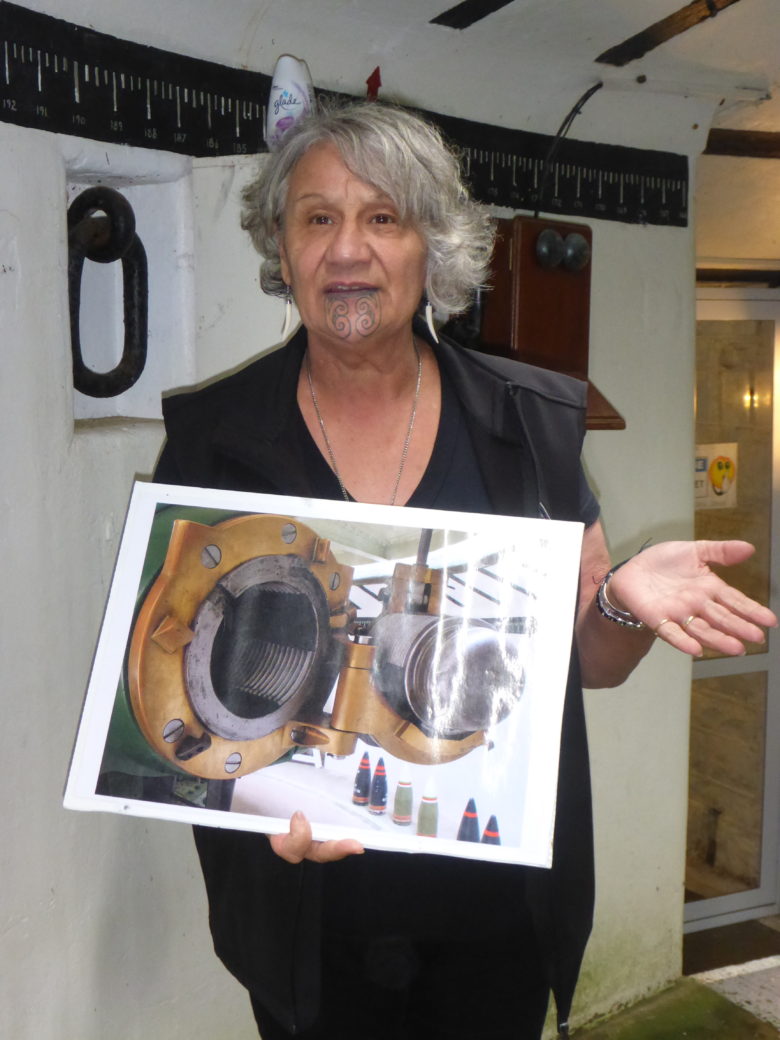The grunting hedgehog was tucked up in his warm bed after a night of hunting around our tent when we drove Vicky to her hospital appointment hoping her problem would not be a major one.
We walked across a railway line and vast park to get into the centre of Christchurch and the I-Site, relocated in a college building since the last earthquake in 2011. Armed with ideas we re-emerged and boarded a tram for the 50 minute circuit of the city, unless one hops on and off of course, which would extend that time. We opted to stay on for the duration, listen to the friendly driver chatting about his shattered city and decide where to re-visit afterwards.
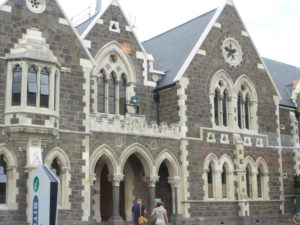
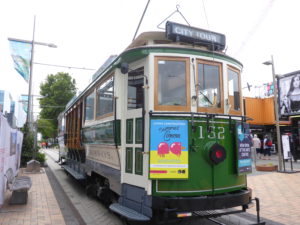
The elderly but perfectly restored tram was built by a company called Boon and since that is my maiden name I wondered if any of my direct ancestors had emigrated out here. Our tram driver changed in their depot and the new one took a wrong turn, which was amusing, as it showed us some parts we would not otherwise have seen and messed up their schedule completely. We had to change trams as a result and start all over again. Ah well, all in a day’s sightseeing.
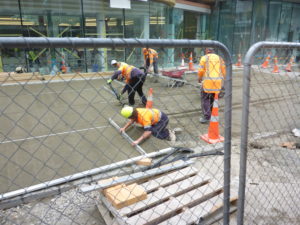

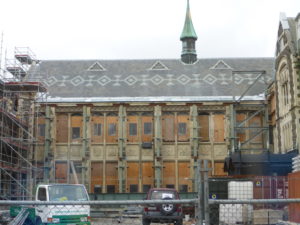
Seventy five percent of Christchurch will have to be re-built after the earthquakes and progress is slow for a number of reasons including the on- going wrangling over whether to repair or demolish and start again and insurance companies denying liability. The Re-start scheme is impressive.
An entrepreneur decided that a quick fix for the loss of amenities such as high street clothes outlets, cafes, bars and shops would be to take 60 containers of the Mersk kind and lay them out in a cleared site of the city and let commerce and social intercourse thrive. Then when all the planning for that site was done and the cement lorries start arriving they move the 60 commercial units to another site.
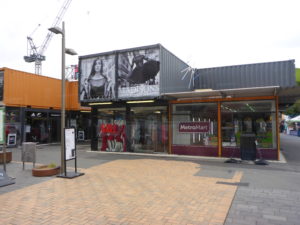
We were sitting outside a pizza bar munching our way through our thin mushroom and feta pizza when Rob’s phone rang, “I’ve found where your car is peessing oil,” our mechanical saviour said, “the seal around the cam shaft is gone and someone tried to fix it with silicone sealant. It’s no problem, I have a new seal and I’ll fit it and do the service this afternoon!” All with a slightly Eastern European accent.
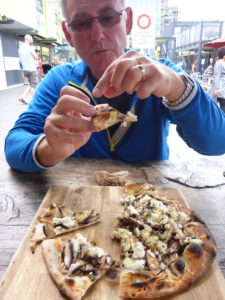
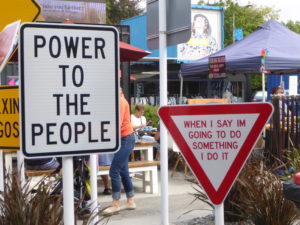
Perfect, $61 for the new seal was well within our budget and a permanent fix to boot, we were destined to enjoy the rest of our day.
Rob enjoyed buying himself a new pair of walking shoes at Ballantynes, his old ones had been smiling at us for days and as it was now raining hard the gap between the toes and soles were letting in water. We walked past a five floor apartment block in the process of construction and designed so that even people on the fifth floor could park their cars outside their own front door.
In the Earthquake centre I watched the video of a civil engineer who sent a drone into the damaged cathedral to do a remote survey of the damage. The main entrance is badly damaged but that was caused by the modern steel girder insert vibrating during the seismic event and shaking the stones to the ground. The drone pictures showed that not a single supporting column in the building is damaged and the debris on the floor is rubble from the carved decorations. Such a clever idea to use a drone as well.
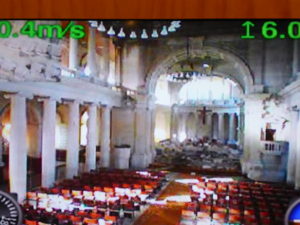
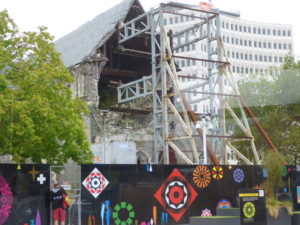
The religious council wants a new cathedral, the secular council wants it repaired as part of Christchurch’s history and society in New Zealand not being overtly religious is mixed in its view. So the congregation goes to the cardboard cathedral that could be in use for some time yet. Since writing the decision has been made to repair the existing building, sanity reigns sometimes.
Such inventive ideas and a city full with mankind dressed in orange and yellow tunics, wearing white helmets, working on sites and relaxing on chairs outside the cafes in the re-start centre. Necessity is certainly stretching creative minds in Christchurch.
Instead of squelching back through the park to the garage we caught two buses back to the garage. At one stop a young lad hooked his bike onto the rack on the front of the bus before paying for his ride. After collecting a healthy Vicky we arrived back at the camp for an unexpected social evening chatting to an Australian couple who we would meet again in Invercargill and German youngsters taking a break from freedom camping and enjoying a nice kitchen and hot showers. No poopers there, they were happy to use the basic facilities.
The next day we drove the short distance to the Antarctic Exhibition near the Airport. It is also the HQ for the Italian, USA and NZ Antarctic project planning and the supply route, via the airport, to the bases out there on the cold wastes. For us we struggled into rubber overshoes and oversize jackets to experience a simulated Antarctic Storm. A young mother had her tiny baby strapped to her front as the room full of novice explorers became dark and the fans increased the wind to gale force and the temperature dropped to minus 42’. Brrrrrh.
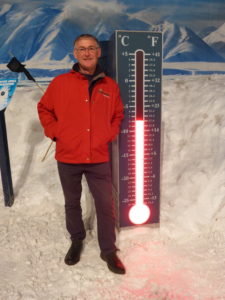
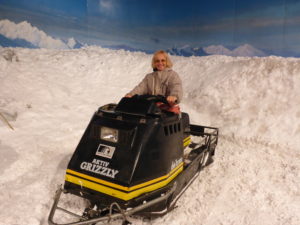
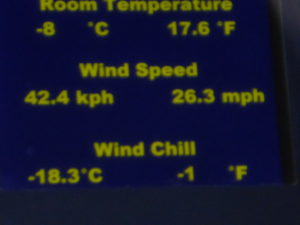
Another intelligent scheme I liked in this inventive city was the free bus from the Antarctic Centre to the City Museum and back, so we didn’t have to find a parking space ourselves. We spent two hours wandering down re-created streets, a young lad posed on a penny farthing and we could peep into offices and living rooms and see how earlier generations lived. There were fine collections of furniture, glass, porcelain and even a room full with everything oriental.
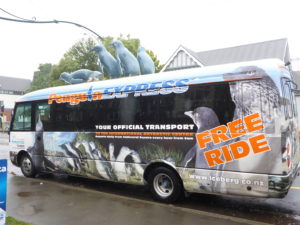
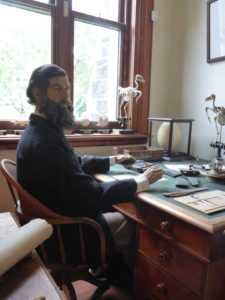
“Oops, sorry didn’t mean to interrupt”.
New Zealanders mourn the loss of all the fine buildings but many will be rebuilt using quake resisting methods like cutting the stones in half lengthways so the walls are thinner and more flexible. The building will look the same as it used to but will absorb vibration rather than resist it. The Women’s Hospital was built on isolation pads made of rubber years ago and has not suffered any earthquake damage in the two major events of recent times.
The Port Hills fires to the south of the city have been raging before and during our stay. Helicopters with their bags of water underneath worked from first light and one pilot had been killed when his helicopter inexplicably crashed into the blackened hills. As we sped out of the city the next day the car was soon filled with reek of smouldering fires and another ‘copter crashed, but this time the pilot survived. So many knocks for one city to endure.
We were heading for Akaroa, a small town nestled on the shores of a lake in the caldera of one of the two volcanoes on the Banks Peninsula not far from Christchurch. Just as the Nelson Lakes were the Riviera for Nelsonians at weekends and summer holidays, Akaroa also had its Riviera era for Christchurch residents. Now it is a destination for foreign visitors and is on the bucket list for the new Asian tourist market as well.
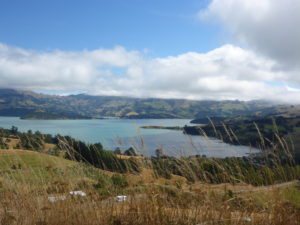
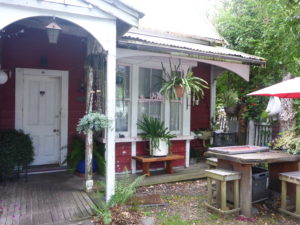
Maori tribes thrived here, Cook stumbled upon the safe anchorage in 1770 and French sealers and whalers were amongst the first settlers from the early 1800’s. The Old Lighthouse has now been moved to the heart of the town for visitors to get a real sense of the seafaring past.
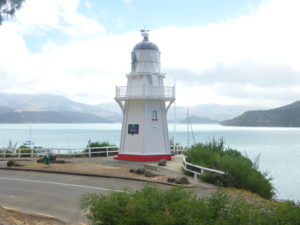
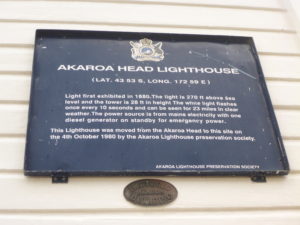
In the yacht club we met a German couple from their red steel yacht who had just arrived from Whangarei after an 8 day non-stop sail. They needed to clean up and do some repairs before continuing on around the south island and then turning north for Japan. Whenever we were near the coast we noted from the agreeable winds and flat sea that this year would not have been a bad one for doing a circumnavigation of the two islands and we wished them safe sailing.
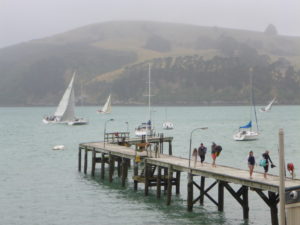
Akaroa is a pretty little place and has turned out a hero or two. Born here, Frank Arthur Worsley, “Now who is he?” You may say, was the Captain of Shackleton’s ship Endurance, which was crushed by the ice during his ill-fated expedition. Captain Worsley then navigated the 23’ James Caird clinker boat 800 miles to South Georgia and returned to rescue the rest of the crew many of whom would later die in WW1 or the Spanish flu epidemic that followed.
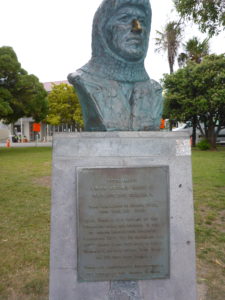
Contrary to what you might think from the photos we don’t often eat out but amongst the restaurants whose prices were within our league was The Akaroa Fish and Chip Shop which sold Elephant fish with chips for $6 and then next door we watered that down with a pint of Original Monteith’s beer at Bully Hayes bar! These are all famous places you understand. Yes that was news to us as well!
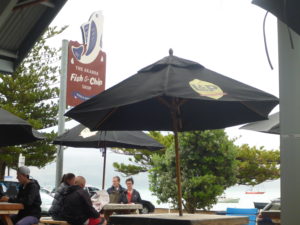
Meanwhile, back at camp, the same French family with the twin girls we had met in Mac Donald’s Farm Campsite next to Abel Tasman back up north, had pitched next to us. They were on their last of 20 nights in their tiny pop up tent, living out of their hired saloon car. “It has been alright, we are all slim so we just fit in the tent, but the girls they do wriggle so!” Their mum revealed. “We are off to stay in our friends’ apartment in Sydney tomorrow,” she continued in a tone of relief.
The view from our tent on its little terrace looking towards the lake was beautiful. Immediately in front of us was the robust childrens’ play area which included a climbing wall leading up to the top of the slide. One of the French girls met the challenge with confidence but her twin sister was more wary. She watched her sister a few times and tried to start the daunting climb. Early the next morning, with no one else around she steadily took each handhold and footstep with care until the vertical bar of the slide was within reach and then with one quick pull she was up, triumphant, bless her.
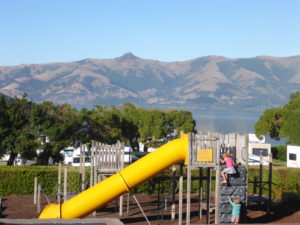
A very tall German father held his baby daughter’s hands as they bounced on the trampoline, 123 and up she went, above her dad’s shoulders at arm’s length, she squealed with glee. It was infectiously funny.
The next day we took in the Museum and learned about local immigrant artist Menzies fusion of European and Maori art to charming effect.
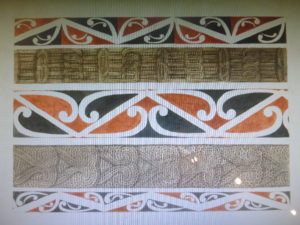
Then it was time for a coffee and shared Danish pastry in the pretty rose garden at the Brasserie Restaurant, the garden enjoyed by customers and mice alike we found, before moving on to the cemeteries; Catholic, Anglican and Pagan! We just wandered around the Anglican one and I noted a grave in which the husband buried both his wives in the same grave, one after the other. We just hoped they got on!
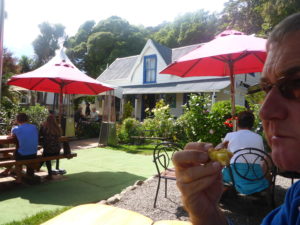
Over the rim of the volcano and in a valley approaching the shore with the sea was some of Menzies artwork at Little Akaroa. But as we approached the summit of the road the fog came down and since the road was gravel and very bendy and steep we did a wheel spinning turnaround and went back to base.
The next morning we burst from the confines of our little tent to go to the shower block and find a couple next to us who have a yacht at Whangarei too, The Ariadne of Stockholm. After a short chat we promised to look them up on our return.
Akaroa is like Christchurch’s well known secret; an expensive little jewel tucked away and yet welcoming to locals and foreigners alike. It sparkled with interest unlike the flat, agricultural land we sped through the next day on our way to Dunedin in Otago Region.
Intense Agriculture on the dry flatlands between Christchurch and Dunedin.
Eighty six percent of this region’s drinking water goes on the irrigation of grasslands to feed, mostly, the vast dairy herds in what would otherwise be the semi-desert of the east coast of S Island around Ashburton. It seems a shame they have the climate for all year round grazing, but not the rainfall in this marginal region.
The cost of producing the milk must be astronomic and much of it goes to the lucrative export market after passing through the giant dairies who cream (!) much of the profit, I just wonder how the farmers are faring. It is always a struggle in a primary industry like agriculture since the farmers cannot question what they pay for feed and water and are told what they will be paid for their milk. Between the devil and the deep blue sea, in this case the lovely passive South Pacific.
The towns were a little light relief from the flat fields to the horizon. Some farmers around here obviously came from Devon in England I thought as we sped through the town of Ashburton. Cheerful bright red tractors lined up precisely infront of the Massey Ferguson dealership. In one place there was a novel Motel where you could stay in a silver silo, complete with windows and your own balcony.
The mighty wide Rakaia River was down to a trickle, clearly this Eastern Southlands Region was suffering a drought; so different to what the weather had in store for the North Island.
Big bales in the fields reflected the big business of farming. NZ magpies in their white cloaks strutted about on the road like barristers summing up in court and acres of lavender, sheep and shiny cows spread to the far horizon.
A Clydesdale Horse Stud surprised us, we wondered what they used them for. Pastimes here are all outdoor activities from bowls in the towns to golf, trotting clubs (one or two horses infront of a very light carriage, a kind of dressage with wheels) and vintage cars in the countryside.
The temperature was rising the further south we went until we approached Timaru on the coast where a cool sea fret reduced it to 21’. Folk were relaxing on the tiny beach in the harbour and we bought ice creams from a café built of rusted steel plates. Very rustic.
The Birds of Otago
Back on the road we were approaching the Otago Region behind a potato chip lorry which sported the slogan “In starch we trust”, I quite liked that. We headed for the Otago Peninsular which runs parallel with the coast enclosing Otago Harbour and was first settled by Maoris 700 years ago. While the early European settlers set up a whaling station and camp at Wellers Rock on the peninsular in 1831 we pitched our little tent in Portobello in 2017. This quiet rural location was close to Dunedin while at the same time just a short car journey from Fort Taiaroa at the outer tip of the peninsular.
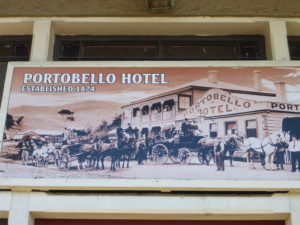
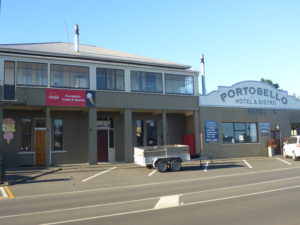

This fort was built in the 1880’s when Britain was sabre rattling with Russia and the threat of a Russian invasion here was thought to be real. It never happened but on the centenary, when big celebrations were to be held, someone forgot to invite many tallships and the only one who could make it at very short notice was, yep you guessed it, Russian. They finally got their Russian invasion albeit small and very friendly.
We met a couple of connections while half Maori Mary was showing us around. W.G. Armstrong was one of those brilliant minds of the Victorian era who was a solicitor by profession but was also as adept at Garden and House design as he was at business and armament manufacture. He invented the Disappearing Gun and one was installed here in 1889, to keep those Ruskies at bay. It rose up out of the ground on a hand pumped water and air system and returned itself to the pit by the sheer force of the recoil or gravity if it hadn’t been fired.
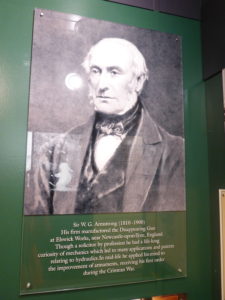
One factor troubled me. Given the brilliance of having a gun painted green to camouflage with the surrounding grass; what happened when the grass turned brown?
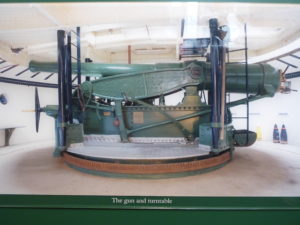
Rob has visited Armstrong’s Garden at Cragside, near Rothbury in Northumberland and I studied his house and garden in my OU Arts Degree.
Mary called me forward from the group because she saw I had a camera. “Make sure the flash is on and take a shot down the barrel,” sounds dangerous I thought. The end result showed the inner core of the gun was spiralled to increase the accuracy of the fire. Since then the tiny jade coloured NZ bird with the delicate chittering song and the tail feathers no longer than its wings is named the Rifleman after Armstrong’s Gun because it spirals around the trunks of the trees it feeds from.
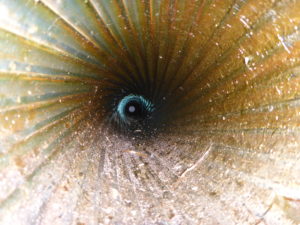
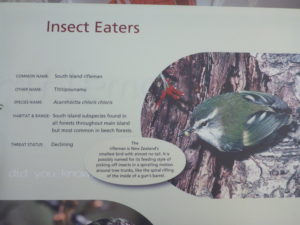
Many years ago and I have no idea where, a young lady named Barbara kept nagging her dad to convert to Christianity. He became so sick of this that to shut her up he chopped off her head. So Saint Barbara became the patron saint of those facing sudden death in general and gunners in particular. She was the reservoir of much praying as the soldiers toiled over the gun here.
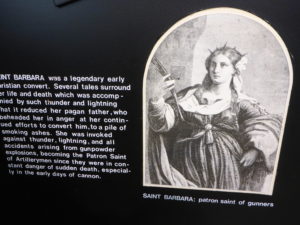
As Mary led us up to the gun emplacement which is now the lookout for the high fenced Royal Albatross Colony Reserve on Taiaroa Head, she paused and turned towards the hill ridge along the side of the reserve. She pointed out where her family have lived over many generations and some still do. Mary retires this month, March and plans to visit the UK, Shetland islands and Avignon with her English husband.
She spoke with immense pride about the 70 years of continuous research, protection and conservation that is being managed at the Nature Reserve by the D o C, Department of Conservation. How necessary is this protection with the ever increasing numbers of Albatross drowned in long line fishing, a predicament so easy to avoid with the use of weights to keep the lines well under water until near the fishing boat.
We watched one uncertain and reticent albatross toddle off down a grass path, away from its nest, towards the cliff edge, harassing a female sitting on her nest on the way. With baited breath we were united “Will he fly, oh no he’s changed his mind.” He opened and flexed his wings a few times and then, when we had almost given up, off he leaped with such grace, embracing his natural element and soaring out to sea.
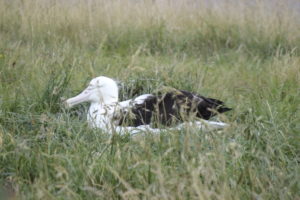
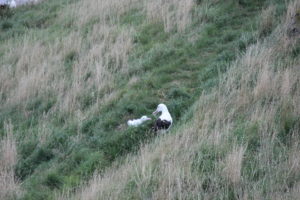
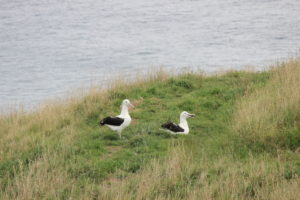
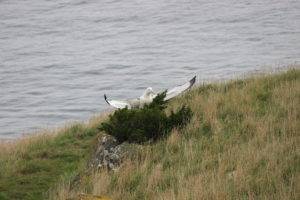
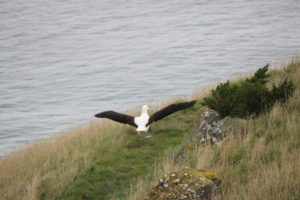
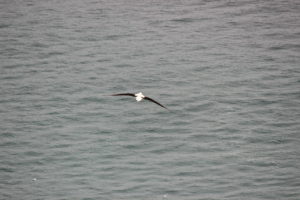
If he was an adult bird he will be among the 85% of adults who return to this spot after two years. If he was a young bird his first circuit of the South Pole will take four years before he returns with 75% of his fellow young birds.
On the same day we were looking forward to returning later to the Reserve to view the little blue penguins who come ashore every evening to their nests, but first we would have some lunch and a look around the little museum in Portobello that is sited in an old settlers house complete with outbuildings.
The museum presents another fascinating account of the lives of the settler families through photos and artefacts. In one of the outbuildings that housed domestic and farming machinery, on the wall, was an advertisement for Nitrate and Phosphate fertiliser dating back to 1870. So the tragic pollution of the once pristine rivers with cattle waste and the leaching of these chemicals out of the ground and into the water courses started 150 years ago. It is surprising how quickly a river can recover under proper management and at last the problem is well known and understood, so hopefully the right action will be taken to clean up the rivers.
Returning to our evening date with the little blues we came across some very chilled fur seals just off the road languishing on the shores of the Otago Sound.
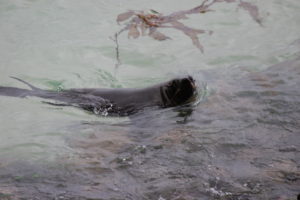
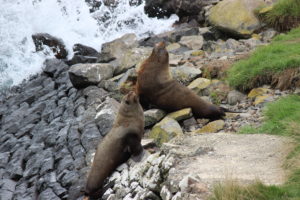
Our little crowd, standing on the fenced and elevated platform, lit from underneath so the penguins couldn’t see us, did not have long to wait for the arrival of the troop of thirty or so penguins. They had to run the gauntlet of marauding seagulls to make it to their well paddled path into the thick grassy area and their nests. It was impossible to get perfectly sharp photos of them as the shutter had to open up and take longer to close than normal to absorb enough light in the near dark conditions, so they were invariably blurred, or ‘soft focus’ as I prefer to call it.
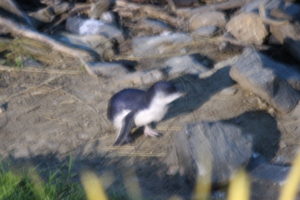
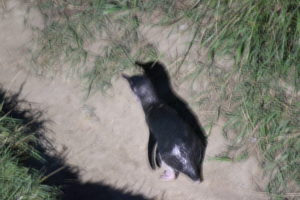
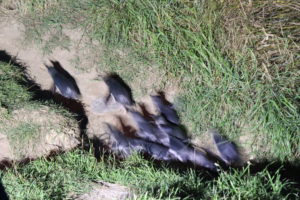
One little chap was convinced there was something up there and stood by our platform for ages staring up at us staring back down at him/her. We were not allowed to let any light come from our cameras, either flash or light meter red as it could damage their eye sight and frighten them. We should not have been there really, any of us.
Enriched by our proximity to such special little creatures we wandered back up the steps to the sounds of their grunting happily as they settled down for the night. Their biggest predators are possums, dogs and car tyres so we drove very carefully back to camp.
